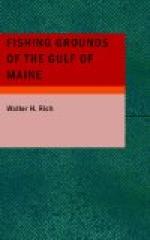There is a small shoal called Pollock Rip, with a depth of 7 fathoms, bearing SW from Seal Island, distant 9 1/2 miles; but otherwise the ground slopes quite gradually, the depths being from 15 to 70 fathoms. The bottom is mainly coarse gravel and pebbles with occasional rocky spots of greater or less extent. The tides sweep over this ground with considerable force out from and in toward the Bay of Fundy. the flood running strongest.
In general, the species of fish found here and the seasons of their greatest abundance are much as on Browns Bank. The principal fishes taken are haddock, cod, cusk, halibut, and hake, and a very small amount of pollock. Except for the haddocking, the best fishing season is from March to October. Halibut are said to have been very plenty here in the past but are said to have been comparatively rare in recent years, although occasional good fares are brought from these grounds, perhaps more commonly in the spring and early summer and a few at other seasons. In April they are found most commonly in 80 fathom depths; in May in 30 to 40 fathoms, in June the best halibuting is had in 25-fathom depths or even in shoaler water. (The halibut catch shown for the year chosen (1927) is unusually small, most years yielding a fair amount of this species from this ground. Apparently no member of the American halibut fleet visited this ground for the year.)
Cod are present here the year around, perhaps the best fishing taking place in May and June, when the fish are found in about 40 fathoms They go into deeper water, about 60 fathoms, in August and into 100 fathoms as the cold weather advances. This Seal Island ground may be considered essentially as a feeding ground for the cod, which seem to appear here after the spawning season is over, to fatten upon the crabs and mollusks living on the bottom and on the herring and other small fish that swim back and forth In the tide rips.
Haddock are also present all the year, the schools being most abundant and the number greatest in January and February, when the fish are in about 50 to 60 fathoms. Apparently they come into depths of from 27 to 30 fathoms in March and April for spawning.
Cusk are present here during most of the year in 80 fathoms on the hard bottom. Pollock are few on this ground at any time of the year. This species, together with herring and mackerel, are abundant on the “shore soundings” of Seal Island Ground, whence, following the abundant food furnished by the smaller fish, they range a short distance in to the Bay of Fundy. Many mackerel are taken in the traps in the vicinity of Yarmouth, Nova Scotia, which seems to mark the limit of their penetration in any considerable schools on the western shore of Nova Scotia.
What is apparently a gradually deepening extension of Seal Island Ground is found about 65 miles SSE. from Mount Desert Rock and 60 miles W. from Seal Island. There seems to be no distinguishing name for this area.




